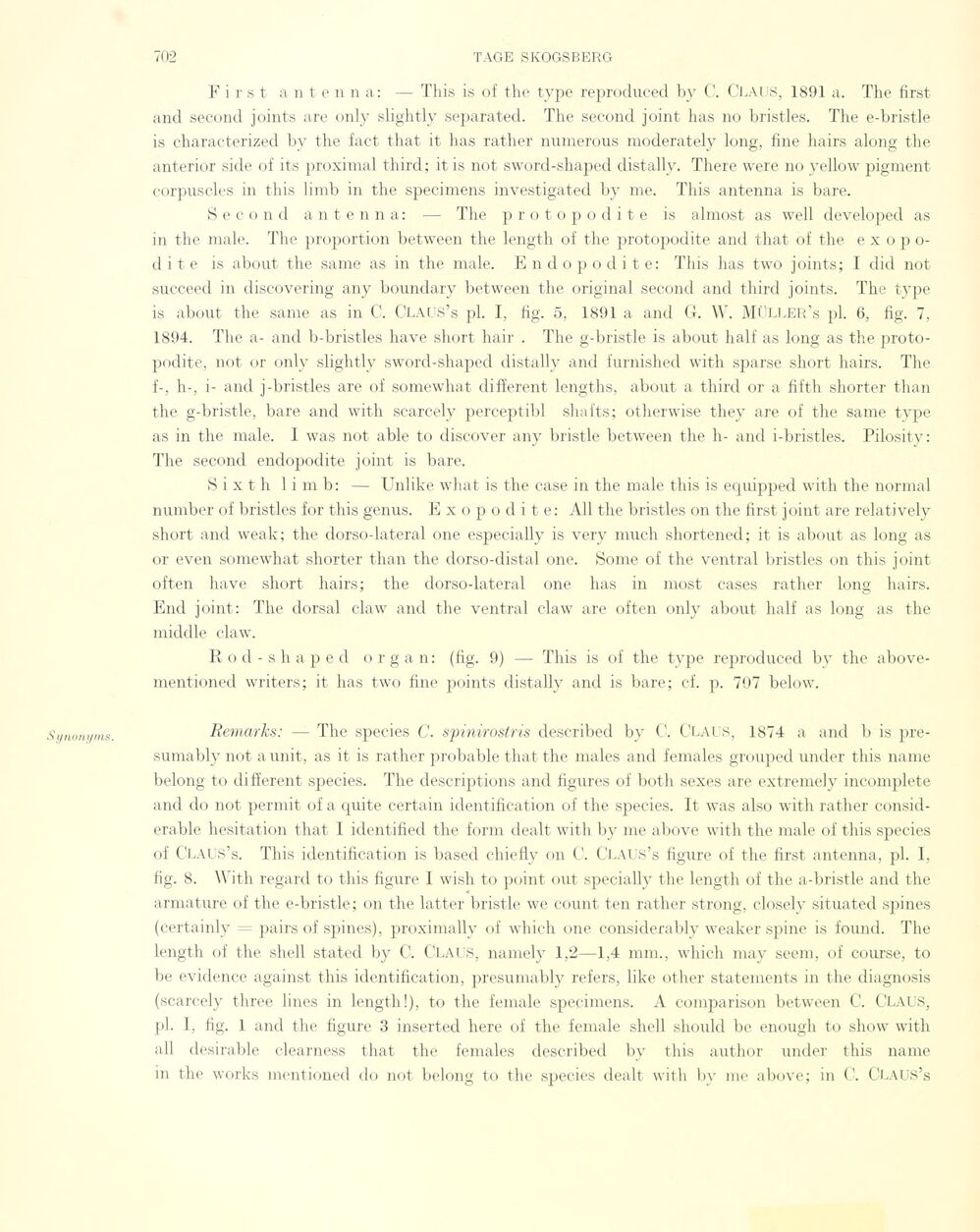
Full resolution (JPEG) - On this page / på denna sida - Sidor ...

<< prev. page << föreg. sida << >> nästa sida >> next page >>
Below is the raw OCR text
from the above scanned image.
Do you see an error? Proofread the page now!
Här nedan syns maskintolkade texten från faksimilbilden ovan.
Ser du något fel? Korrekturläs sidan nu!
This page has never been proofread. / Denna sida har aldrig korrekturlästs.
S y no ny nis.
First antenna: — This is of the type reproduced by C. Claus, 1891 a. The first
and second joints are only slightly separated. The second joint has no bristles. The e-bristle
is characterized by the faet that it has rather numerous moderately long, fine hairs along the
anterior side of its proximal third; itis not sword-shaped distally. There were no yellow pigment
corpuscles in this limb in the specimens investigated by me. This antenna is bare.
Second antenna: — The protopodite is almost as well developed as
in the male. The proportion between the length of the protopodite and that of the e x o p
o-d i t e is about the same as in the male. Endopodite: This has two joints; I did not
succeed in discovering any boundary between the original second and third joints. The type
is about the same as in C. Claus’s pi. I, fig. 5, 1891 a and G. W. MÜller’s pi. 6, fig. 7,
1894. The a- and b-bristles have short hair . The g-bristle is about half as long as the
protopodite, not or only slightly sword-shaped distally and furnished with sparse short hairs. The
f-, h-, i- and j-bristles are of somewhat different lengths, about a third or a fifth shorter than
the g-bristle, bare and with scarcely perceptibl shafts; otherwise they are of the same type
as in the male. I was not able to discover any bristle between the h- and i-bristles. Pilosity:
The second endopodite joint is bare.
S i x t h limb: — Unlike what is the case in the male this is equipped with the normal
number of bristles for this genus. Exopodite: All the bristles on the first joint are relati vely
short and weak; the dorso-lateral one especially is very much shortened; it is about as long as
or even somewhat shorter than the dorso-distal one. Some of the ventral bristles on this joint
often have short hairs; the dorso-lateral one has in most cases rather long hairs.
End joint: The dorsal claw and the ventral claw are often only about half as long as the
middle claw.
R o d - s h a p e d organ: (fig. 9) — This is of the type reproduced by the
above-mentioned writers; it has two fine points distally and is bare; cf. p. 707 below.
Remarks: — The species C. spinirostris described by C. CLAUS, 1874 a and b is
pre-sumably not a unit, as it is rather probable that the males and females grouped under this name
belong to different species. The descriptions and figures of both sexes are extremely incomplete
and do not permit of a quite certain identification of the species. It was also with rather
considérable hésitation that I identified the form dealt with by me above with the male of this species
of Claus’s. This identification is based chie fly on C. Claus’s figure of the first antenna, pl. I,
fig. 8. With regard to this figure I wish to point out specially the length of the a-bristle and the
armature of the e-bristle; on the latter bristle we count ten rather strong, closely situated spines
(certainly = pairs of spines), proximally of whieh one considerably weaker spine is found. The
length of the shell stated by C. CLAUS, namely 1,2—1,4 mm., wliich may seem, of course, to
be evidence against this identification, presumably refers, like other statements in the diagnosis
(scarcely three lines in length!), to the female specimens. A comparison between C. CLAUS,
pl. I, fig. 1 and the figure 3 inserted liere of the female shell should be enough to show with
all desirable clearness that the females described by this author under this name
in the works mentioned do not belong to the species dealt with by me above; in C. CLAUS’s
<< prev. page << föreg. sida << >> nästa sida >> next page >>